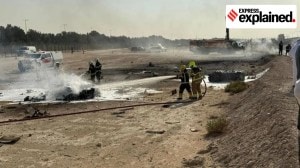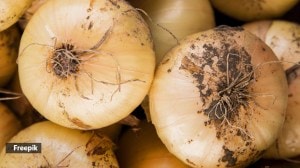The food disappears with the floods
The plains of eastern Uttar Pradesh -- an area contiguous with the northern Bihar plains -- are among the most water rich in the country. ...

The plains of eastern Uttar Pradesh — an area contiguous with the northern Bihar plains — are among the most water rich in the country. The entire region is criss-crossed by three major rivers — the Ghaghra in the west, Rapti in the centre, and Gandak (Choti and Burhi) in the east — and almost over a hundred tributaries, all forming part of the great Gangetic system.
This availability of water has attracted people to these plains and the population density here is 614 persons/km, as against a national average of 474 persons/km. Abundant water resources, fairly high rainfall, rich soil and manpower in plenty make agriculture the main occupation of the people here. The gross sown area is 36.5 lakh hectare. Rice and wheat have been the major crops, while corn, pulses, oilseeds, surgarcane, potato, and so on, have also been grown in plenty.
The extensive network of rivers and the low gradient of land also make Purvanchal extremely vulnerable to floods. Earlier, floods were rarely threatening and caused, at the most, temporary discomfort and minor damages. The monsoons and the rivers in spate demanded from the people only minor readjustments to their lifestyles because the floods rarely stayed for long — at the most for a week or ten days. On the other hand, the benefits that the monsoon floods brought were immense. No wonder, when the floods came the women of the villages sang songs in welcome.
As a river heavy with water overflowed its banks, its unhindered spread carried rich, mineralised silt to the fields. This silt was the most enduring gift that the floods gave the farmers. There are numerous references in district gazettes about how the loss of kharif was more than compensated for by a bumper rabi harvest thanks to the deposits left by the waters of receding floods.
But over the last decade or so, the situation has changed — for the worse. At the peak of summer, the farmer still looks heavenwards and awaits the rains, but with a sense of fear as well because floods are no longer a boon. They are more frequent, come with ever-increasing ferocity and stay in the area for longer durations.
The reasons are not so much natural as manmade. And, ironically, this change in the nature and effect of floods came about with the building of embankments, which were constructed for exactly the opposite purposes — to protect the people and villages from floods! Earlier, with no or only shallow, temporary embankments, a river in spate would overflow a large area, carrying its water and heavy silt load wide across the fields. Now, with a river curbed by embankments, the silt remains confined within the river and this raises the level of the river bed, forcing the river to flow with greater speed and intensity, and causing that much more damage during the monsoons.
Once the rains cease, the embankments do not allow the flood overflow to recede and return to the river, thereby causing water to remain longer on the land. Even after it recedes, large patches remain waterlogged. This has its repercussions on agriculture. The land not drying out in time delays the sowing for the next crop. Even if sowing is perforce done under such conditions, it results in poor seed germination.
Moreover, in Purvanchal, between the kharif and rabi crops, there is an intermediate period for growing pulses and oilseeds. But the waterlogging has, over the years, led to a general decline of this cropping, resulting in a steadily decreasing area for the pulses, grams and oilseeds. In fact, in quite some places in Purvanchal, these have virtually become extinct. Likewise, many other traditional rops are also no longer grown.
Floods affect not just standing crops, but stored grain as well. With water entering houses, the family’s hard-earned storage of grains and precious seeds for the next season, besides cattle fodder, also get spoiled and rot. This causes large-scale scarcity of foodgrains, vegetables and fodder, starting a chain of problems and miseries. Among the more vulnerable, it could lead to immediate shortage of food, to malnutrition, to conditions of hunger, to an increasing dependence on the market, to bonded labour or even suicide. After the 1998 floods in Purvanchal, many of the flood-affected regions reported chronic cases of starvation and large-scale unemployment.
At the same time, with the silt now trapped within the embankments and no longer reaching the fields, the farmers are deprived of that natural, virtually unlimited fertilizer, leading to increased market dependency and growing use of chemical fertilizers.
Agriculture in the once bountiful regions has today become more and more cost deficient, with infrastructures weakened, resources depleted and local and traditional support systems falling apart. Farmers have been forced to change their crops and cropping patterns, go in for fine cereals instead of coarse grains, and shift to cash crop agriculture in place of self-sustaining farming. Long-stalked traditional varieties of paddy seeds, which used to withstand the foods so well, have now given way to the dwarf varieties, which perish easily in the floods. Purvanchal was once known for its kharif crops, but now the diversity and sustainability of the summer cultivation has been considerably reduced and has ultimately led to more food insecurity in the area.
For the small and marginal farmers, particularly, this often means degenerating into an endless cycle of debt. They are sometimes forced them to give up farming and migrate, adding to a further deterioration of the agriculture scenario in the region. When able-bodied men and women begin to leave, the region suffers for want of development, giving rise to yet another cycle of deprivation. It is a vicious circle.
Unfortunately, most of the discussions in the country on disaster by floods has focused on the economic costs of destruction to life and property, and the response of the government to devastation from floods has largely remained limited to providing token relief. The authorities just don’t realise that their poor and shortsighted management of floods has led to a steady deterioration of agriculture, the increasing marginalisation of the small farmer and a threat to the region’s food security.
With more and more land being affected by floods every year, the farmers are able to grow less and less. From two to three crops a year, in any areas today the farmer is only able to grow one single decent crop a year. This has resulted in a once-bountiful region suffering from acute poverty, less productive land and widespread disease.
The author was a member of an independent People’s Commission on Floods in Eastern Uttar Pradesh, 1998
Readers can send feedback to focusexpressindiacom.
>



- 01
- 02
- 03
- 04
- 05




























